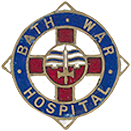Health and Well-Being
The City of Bath had always been famous as a centre of healing, and its medical research and learning was much needed to treat the wounded soldiers who became patients at the War Hospital. Dr. Preston-King, the Mayor of Bath when war was declared and again in 1918, had previously introduced X-rays to the Royal United Hospital with the Bath engineer John Rudge. The Bath War Hospital was able to be similarly equipped thanks to the generosity of Alderman Cedric Chivers, who paid for the entire cost of a building and equipment that became known as Q Block. He also provided electricity free of charge via a wire connected to his bookbinding works. X-rays were essential for locating bullets before surgery and in the diagnosis of gas gangrene.

Cedric Chivers
Q Block had more to offer than X-rays. By the end of WW1 nearly 2 million British soldiers had been permanently disabled, over 40,000 of who had lost limbs. Q Block, under the charge of Dr. King Martyn and his chief nurse Marjorie Clark, was able to offer a range of therapies, such as whirlpool baths, electrical treatments and massage, to aid the recovery of wasted muscles and tissues, twisted limbs and stiffened joints, and to treat shell shock. Comparatively few military hospitals possessed such a facility, and soldiers were sent from other establishments to benefit from the treatments offered.
